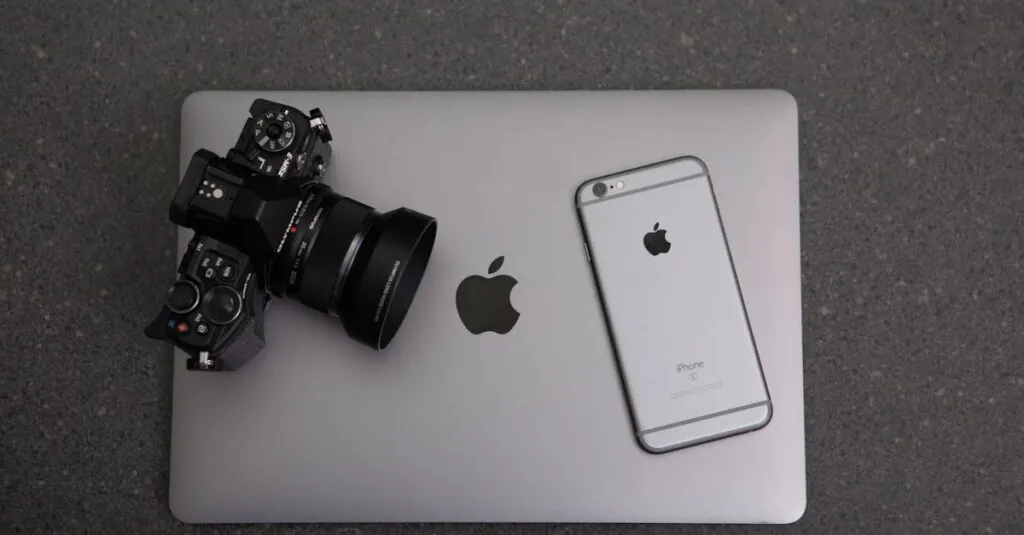In a world where desktop accessories reign supreme, finding the right ones can feel like searching for a needle in a haystack—or worse, like trying to assemble IKEA furniture without the instructions. From quirky mouse pads to ergonomic keyboards, the right accessories can transform a mundane workspace into a productivity powerhouse. But how do you separate the gems from the junk?
Overview of Desktop Accessory Test
Desktop accessory tests evaluate the quality and functionality of various products designed to enhance the workspace. These tests focus on essentials like mouse pads, keyboards, and monitors, assessing their performance in real-world use. Observations from these evaluations determine which accessories boost productivity and provide comfort.
Functionality plays a crucial role in the testing process. Ergonomic keyboards, for instance, often receive high ratings due to their ability to reduce strain during extended typing sessions. High-precision mice contribute significantly to user efficiency, especially in design or gaming environments. Adjustments in design or features can greatly influence user experience.
Testing also includes material quality. Durable mouse pads withstand frequent use without showing signs of wear. Assessments reveal that high-quality materials can enhance performance and longevity. Users should consider the tactile feel and surface texture, as these factors directly affect productivity levels.
Additionally, design and aesthetics impact overall satisfaction. Accessories that align with users’ personal style can create an inviting workspace. Color schemes and unique designs help foster creativity. Evaluations often measure user preferences alongside performance metrics.
Finally, each tested accessory generates feedback valuable for both manufacturers and consumers. Comprehensive reviews highlight top performers and suggest areas for improvement. Reviewing these insights ensures informed purchasing decisions and contributes to a more effective workspace.
Desktop accessory tests provide essential data, guiding users toward choices that align with their needs and enhance their daily work experiences.
Importance of Desktop Accessories
Desktop accessories play a vital role in creating an efficient and comfortable workspace. Selecting the right accessories can significantly impact daily work experiences.
Enhancing Productivity
Quality desktop accessories directly influence productivity levels. Ergonomic keyboards and high-precision mice streamline typing and navigation, minimizing errors and reducing time spent on tasks. Choosing items like customizable mouse pads can improve workflow by offering quick access to frequently used shortcuts. Accessories designed for specific needs allow users to complete projects faster. Effective organization tools, such as cable management solutions, help maintain a clutter-free environment, enhancing focus. Prioritizing these elements leads to better overall output.
Improving Ergonomics
Ergonomics greatly affects user health and comfort. Desktop accessories designed with ergonomics in mind promote proper posture and reduce strain during long hours of work. Adjustable monitor stands position screens at eye level, minimizing neck strain. Supportive wrist rests prevent discomfort during typing and mouse use. Well-designed chairs enhance seating comfort, aiding in maintaining focus on tasks. Accessory quality should not be overlooked, as durable materials can provide better support and stability. Prioritizing ergonomic options ensures a healthier workspace experience.
Types of Desktop Accessories
Desktop accessories encompass a variety of tools that optimize the workspace. Selecting the right types can significantly enhance productivity and comfort.
Input Devices
Input devices play a crucial role in user interaction. These include ergonomic keyboards, high-precision mice, and graphic tablets. Ergonomic keyboards reduce strain by promoting natural hand positioning. High-precision mice provide accuracy, benefiting tasks requiring attention to detail. Graphic tablets enhance creativity, especially for designers. Investing in quality input devices supports longer, more productive work sessions.
Organization Solutions
Organization solutions help maintain a tidy workspace. Cable management systems effectively reduce clutter by hiding cords and wires. Desk organizers keep essential items accessible, improving efficiency during tasks. File organizers prevent disarray and make retrieving documents easy. Drawer dividers streamline storage, ensuring everything has its place. Investing in these solutions results in a more focused environment, amplifying productivity.
Decorative Items
Decorative items add a personal touch to the workspace. Unique mouse pads express individual style and creativity. Desk plants contribute to a calming atmosphere, potentially boosting mood and inspiration. Artwork or motivational prints provide visual stimulation and encouragement. Customizable accessories promote a sense of ownership, fostering engagement with the workspace. Considering these items enhances the overall work experience and satisfaction.
Testing Methodology for Desktop Accessories
Testing methodologies for desktop accessories focus on evaluating key aspects that determine their effectiveness and suitability. These assessments ensure users select the most appropriate tools for enhancing productivity and comfort.
Criteria for Evaluation
Evaluation criteria include functionality, ergonomics, and material quality. Functionality assesses how well an accessory performs its intended tasks. Ergonomics examines comfort and support, especially for items like keyboards and mice. Material quality focuses on durability and longevity, with high-quality materials increasing performance and lifespan.
Testing Procedure
The testing procedure comprises real-world use assessments, where items are evaluated under normal conditions. Users operate the accessories over extended periods to gauge comfort and ease of use. Observations are taken on performance, including responsiveness and accuracy for input devices. Ratings are compiled based on user feedback and expert analysis, ensuring a comprehensive evaluation of each accessory’s strengths and weaknesses.
Key Findings from Desktop Accessory Test
Desktop accessory tests reveal essential insights that guide users toward optimal choices. The evaluation of various products highlights significant findings on performance, comfort, and durability.
Top Performers in Each Category
Input devices stand out with ergonomic keyboards and high-precision mice receiving top ratings. Users consistently report enhanced typing speeds and reduced hand strain. Organization solutions like cable management systems excel by promoting a tidy workspace and decreasing distractions. Durable desk organizers streamlining access to essentials also rank highly. Decorative items such as stylish mouse pads contribute positively to user satisfaction by fostering a creative environment.
Common Issues Identified
Common issues often surface during testing sessions. Users frequently note discomfort associated with certain keyboard designs, leading to reduced productivity. Cable management solutions occasionally fail to accommodate varying wire sizes, creating clutter. Several decorative items lack quality materials, resulting in premature wear. Additionally, some input devices exhibit lag during use, affecting the overall experience. Addressing these challenges can enhance product effectiveness and user satisfaction.
Choosing the right desktop accessories is crucial for creating a productive and comfortable workspace. The insights gained from rigorous testing help users make informed decisions tailored to their needs. Prioritizing ergonomic designs and quality materials can significantly enhance daily work experiences.
By investing in the right input devices and organization solutions, individuals can reduce strain and maintain focus. Additionally, incorporating decorative items that resonate with personal style can foster creativity and inspiration.
Ultimately, the right accessories not only improve functionality but also contribute to a healthier work environment. Embracing these insights will lead to a more effective and enjoyable workspace.













